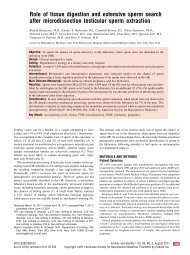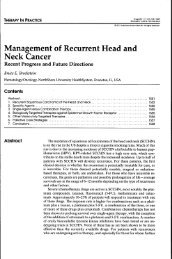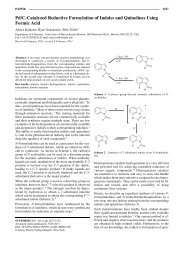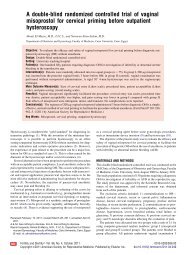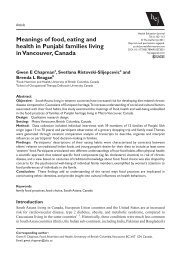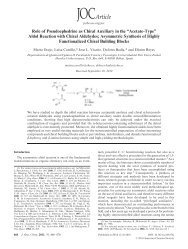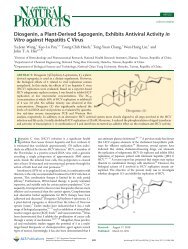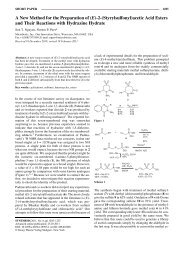Cardioscopy-guided surgery: Intracardiac mitral and tricuspid valve ...
Cardioscopy-guided surgery: Intracardiac mitral and tricuspid valve ...
Cardioscopy-guided surgery: Intracardiac mitral and tricuspid valve ...
Create successful ePaper yourself
Turn your PDF publications into a flip-book with our unique Google optimized e-Paper software.
Shiose et al Evolving Technology/Basic Science<br />
<strong>Cardioscopy</strong>-<strong>guided</strong> <strong>surgery</strong>: <strong>Intracardiac</strong> <strong>mitral</strong> <strong>and</strong> <strong>tricuspid</strong> <strong>valve</strong><br />
repair under direct visualization in the beating heart<br />
Akira Shiose, MD, PhD, a Tohru Takaseya, MD, PhD, a Hideyuki Fumoto, MD, a Tetsuya Horai, MD, a<br />
Hyun-Il Kim, MD, a Kiyotaka Fukamachi, MD, PhD, a <strong>and</strong> Tomislav Mihaljevic, MD b<br />
Objective: <strong>Cardioscopy</strong> is a novel imaging method that allows closed-chest, real-time fiberoptic imaging of<br />
intracardiac structures. This study tested the feasibility <strong>and</strong> safety of cardioscopy as a platform for <strong>mitral</strong> <strong>and</strong><br />
<strong>tricuspid</strong> <strong>valve</strong> <strong>surgery</strong> in the beating heart.<br />
Methods: Through a median sternotomy, cardiopulmonary bypass was established in 10 calves. Lactated<br />
Ringer’s solution was administered through the pulmonary artery to eliminate residual blood volumes in the<br />
lung vasculature <strong>and</strong> was drained through a left ventricular cannula. A fiberoptic cardioscope within its translucent<br />
outer sheath was inserted through the left ventricle. Irrigating solution was continuously administered<br />
through the cardioscope sheath for clearer visualization. An endoscopic clip was used for edge-to-edge repair<br />
of the <strong>mitral</strong> <strong>and</strong> <strong>tricuspid</strong> <strong>valve</strong>s. After <strong>mitral</strong> <strong>valve</strong> clipping, the cardioscope was inserted into the right ventricle.<br />
The solution was administered from the right atrium <strong>and</strong> continuously drained from the pulmonary artery.<br />
After <strong>tricuspid</strong> <strong>valve</strong> repair, the animal was weaned from cardiopulmonary bypass.<br />
Results: Successful double-<strong>valve</strong> repair was carried out in all 10 cases. All calves were weaned from cardiopulmonary<br />
bypass with dobutamine only. Hematocrit values were maintained during the procedure (pre 29.0%<br />
3.1% vs post 28.5% 3.6%, P ¼ .70).<br />
Conclusions: This study showed the technical feasibility of beating heart <strong>valve</strong> <strong>surgery</strong> using direct cardioscopic<br />
visualization. <strong>Cardioscopy</strong> represents a promising platform for future interventions <strong>and</strong> <strong>surgery</strong> under<br />
direct visualization in the beating heart. (J Thorac Cardiovasc Surg 2011;142:199-202)<br />
Although endoscopes have been used in a variety of minimally<br />
invasive surgical approaches, an endoscopic system<br />
for real-time visualization of moving intracardiac structures<br />
has been limited by the amount of blood in the beating heart,<br />
which obscures the site targeted for <strong>surgery</strong> or intervention.<br />
1,2 Even a small amount of blood can prevent<br />
surgeons from obtaining a sufficiently clear image from<br />
the cardioscope. Meanwhile, several attempts have been<br />
made to view the naturally moving <strong>valve</strong>s in vivo.<br />
Imaging through blood using infrared light has been<br />
performed in animal experiments <strong>and</strong> applied to some<br />
human cases. 3 Investigators demonstrated the feasibility<br />
of this approach but also showed the remaining technical<br />
From the Department of Biomedical Engineering, a Lerner Research Institute, <strong>and</strong> Department<br />
of Thoracic <strong>and</strong> Cardiovascular Surgery, b Clevel<strong>and</strong> Clinic, Clevel<strong>and</strong>,<br />
Ohio.<br />
This work was supported by a grant from the United States Army Telemedicine <strong>and</strong><br />
Advanced Technologies Research Center (award number W81XWH-05-1-0564, to<br />
K.F.) <strong>and</strong> a grant from the Global Cardiovascular Innovation Center (Clevel<strong>and</strong>,<br />
Ohio, to T.M.).<br />
The authors independently developed this technology <strong>and</strong> had full control of the design<br />
of the study, methods used, outcome measurements, <strong>and</strong> production of the<br />
written report.<br />
Disclosures: Authors have nothing to disclose with regard to commercial support.<br />
Received for publication June 16, 2010; revisions received Aug 27, 2010; accepted<br />
for publication Sept 14, 2010; available ahead of print Dec 9, 2010.<br />
Address for reprints: Tomislav Mihaljevic, MD, Department of Thoracic <strong>and</strong> Cardiovascular<br />
Surgery, J4-1, Clevel<strong>and</strong> Clinic, 9500 Euclid Avenue, Clevel<strong>and</strong>, OH<br />
44195 (E-mail: mihaljt@ccf.org).<br />
0022-5223/$36.00<br />
Copyright Ó 2011 by The American Association for Thoracic Surgery<br />
doi:10.1016/j.jtcvs.2010.09.053<br />
challenges of limited field of visualization. We previously<br />
reported results on using the cardioscopy system to visualize<br />
intracardiac structures within a non-arrested heart on<br />
cardiopulmonary bypass (CPB) <strong>and</strong> a secondary perfusion<br />
circuit, using lactated Ringer’s solution. 4 Major improvements<br />
have been made to this system, <strong>and</strong> we hypothesized<br />
that our current protocol would enable surgeons to perform<br />
intracardiac beating heart <strong>surgery</strong> more easily, precisely,<br />
<strong>and</strong> safely. The purpose of this study was to assess the feasibility<br />
<strong>and</strong> safety of intracardiac <strong>surgery</strong> using this novel<br />
approach in an open-chest beating heart bovine model.<br />
MATERIAL AND METHODS<br />
Animal Preparation<br />
Ten healthy male Holstein calves (body weight, 103.0 6.1 kg; Mikesell<br />
Farms, Frazeysburg, Ohio) were used for this study. This study was<br />
approved by Clevel<strong>and</strong> Clinic’s Institutional Animal Care <strong>and</strong> Use Committee,<br />
<strong>and</strong> all animals received humane care in compliance with the<br />
‘‘Guide for the Care <strong>and</strong> Use of Laboratory Animals’’ (Institute of Laboratory<br />
Animal Resources, Commission on Life Sciences, National Research<br />
Council, National Academy Press, Washington, DC, 1996).<br />
Surgical Procedure <strong>and</strong> Imaging<br />
The animals were anesthetized with ketamine (10 mg/kg, intramuscularly)<br />
followed by isoflurane inhalation via mask. After endotracheal intubation,<br />
ventilation was maintained through an endotracheal tube attached to<br />
a respirator. Anesthesia was maintained with isoflurane (0.5%–2.5%). The<br />
animal was placed on the surgical table in a supine position. The electrocardiogram<br />
was monitored during the procedure. The heart was accessed<br />
through a median sternotomy. Lidocaine (2 mg/kg/h, intravenous) was continuously<br />
given to prevent ventricular arrhythmia. An arterial pressure line<br />
The Journal of Thoracic <strong>and</strong> Cardiovascular Surgery c Volume 142, Number 1 199<br />
ET/BS
ET/BS<br />
Evolving Technology/Basic Science Shiose et al<br />
Abbreviations <strong>and</strong> Acronyms<br />
CPB ¼ cardiopulmonary bypass<br />
LA ¼ left atrium<br />
LV ¼ left ventricle<br />
PA ¼ pulmonary artery<br />
RV ¼ right ventricle<br />
was inserted into the left internal thoracic artery, <strong>and</strong> the pressure was measured<br />
during the procedure. The pericardium was opened widely. The superior<br />
<strong>and</strong> inferior venae cavae <strong>and</strong> the main pulmonary artery (PA) were<br />
exposed <strong>and</strong> isolated. A 24F arterial cannula was inserted into the ascending<br />
aorta through purse-string sutures, <strong>and</strong> short <strong>and</strong> long versions of an<br />
L-shaped 28F venous cannula were inserted, respectively, into the superior<br />
vena cava <strong>and</strong> the right atrium-inferior vena cava toward the inferior vena<br />
cava. A 20F cannula was inserted into the PA to perfuse the lactated<br />
Ringer’s solution. A fluid-filled line was inserted into the left atrium (LA)<br />
to monitor LA pressure. After full heparinization (300 U/kg), CPB was initiated<br />
<strong>and</strong> systemic flow was maintained at 5.0 L/min. A 24F soft venous<br />
perfusion cannula was also inserted into the LA. A gastroscope (Olympus<br />
GIF-130, 9.8 mm, 103 cm; Olympus, Center Valley, Pa) was used as a cardioscope.<br />
The cardioscope, enclosed in a translucent outer sheath, was inserted<br />
into the left ventricle (LV) through the anterior middle-apex LV wall<br />
directly. The outer sheath was specially designed <strong>and</strong> made of polyurethane<br />
(Figure 1). A communicating space between the distal end of the cardioscope<br />
<strong>and</strong> the sheath allowed the infused solution to clear the area in front<br />
of the lens of the cardioscope effectively. A 32F soft venous cannula was<br />
inserted into the LV apex to drain the solution (Figure 2).<br />
First, the main PA was clamped at the proximal site of the inserted cannula,<br />
<strong>and</strong> 1.0 L of the normothermic lactated Ringer’s solution was administered<br />
for 1 minute at the rate of 1.0 L/min to the distal PA to flush out any<br />
remaining blood in pulmonary vasculature using a separate pump. The ascending<br />
aorta was not clamped, <strong>and</strong> the irrigated fluid was drained mainly<br />
from the LV cannula. Hemodilution was avoided by using CAPIOX Hemoconcentrators<br />
(reference 62648; TERUMO, Elkton, Md) continuously<br />
throughout the experiment. Then, the solution was administered through<br />
the LA before left-side visualization (2.0 L/min, 1 minute). LA pressure<br />
was kept at less than 10 mm Hg to avoid heart distention. During visualization<br />
of the LV, the solution was continuously infused through the outer<br />
sheath at a rate of 2.0 L/min. Both the mid portion of the anterior <strong>and</strong> posterior<br />
leaflets of the <strong>mitral</strong> <strong>valve</strong> were approximated with an endoscopic<br />
clip (Olympus, HX-201UR-135L, http://www.olympuskeymed.com/<br />
index.cfm) introduced through the cardioscope, in a fashion similar to<br />
interventional edge-to-edge repair. 5 An endoscopic clip was proceeded to<br />
the leaflets <strong>and</strong> opened. In most of the cases, the leaflets were caught by<br />
FIGURE 1. Cardioscope <strong>and</strong> the outer sheath. The holding fixture (A)<br />
with several holes is applied to place the scope at the center of the sheath.<br />
Clear lactated Ringer’s solution is infused from the side hole of the outer<br />
sheath (B) to clear the area in front of the lens of the cardioscope through<br />
the holes of the fixture. White arrows show the direction of the flow of clear<br />
solution. The proximal part of the outer sheath is snared to infuse the solution<br />
only toward the heart.<br />
200 The Journal of Thoracic <strong>and</strong> Cardiovascular Surgery c July 2011<br />
both ends of the clips at the systolic phase, <strong>and</strong> then the leaflet captures<br />
were performed by just closing the clips. After de-airing of the LV, the<br />
LV <strong>and</strong> LA cannulae along with the cardioscope were removed <strong>and</strong> the<br />
PA was declamped. The calves were weaned from CPB supported with<br />
a low dose of dobutamine, <strong>and</strong> hemodynamics after weaning from CPB<br />
were confirmed to be stable for 10 minutes.<br />
CPB was resumed for the repair of the <strong>tricuspid</strong> <strong>valve</strong>. A 24F soft<br />
venous cannula was inserted into the right atrial appendage to perfuse<br />
the solution (Figure 3). The coronary sinus was occluded epicardially.<br />
Both venae cavae were occluded for total bypass. The cardioscope within<br />
its sheath was inserted into the right ventricle (RV) through the anterior<br />
middle RV wall. The PA was clamped distally from the PA cannula, which<br />
enabled the complete isolation of the right heart. The solution was administered<br />
continuously through the outer sheath (2.0 L/min). The edges of the<br />
anterior <strong>and</strong> septal leaflets were approximated with the clip introduced<br />
though the cardioscope. After weaning the animal from CPB with dobutamine,<br />
stable hemodynamics were confirmed for 10 minutes. All video<br />
images were recorded digitally at the time of the experiment<br />
(Sony DCR-TRV480; Sony Corp, Tokyo, Japan). Hematocrit values were<br />
measured hourly throughout the procedure.<br />
Autopsy Evaluation<br />
After the completion of the procedure, the animals were killed by intravenous<br />
administration of potassium chloride (240 mEq) under deep anesthesia<br />
with 5% isoflurane. The clips were accessed from the right<br />
atrium, RV, <strong>and</strong> LV with the heart still in the chest. After excision of the<br />
heart, the clip on the <strong>mitral</strong> <strong>valve</strong> was evaluated from the LA. The intracardiac<br />
structures were evaluated macroscopically.<br />
FIGURE 2. Schema of the actual surgical approach to the <strong>mitral</strong> <strong>valve</strong>.<br />
CPB is established between the venae cavae <strong>and</strong> aorta. The cardioscope,<br />
enclosed in its sheath, is inserted from the LV anterior middle-apex. The<br />
cannulae by which the solution is infused are inserted into the PA <strong>and</strong><br />
LA. The drainage cannula for a solution is inserted into the LV. The<br />
main PA is clamped to reduce the amount of blood returning to the left<br />
heart. Ao, Aorta; PA, pulmonary artery; LA, left atrium; LV, left ventricle;<br />
RA, right atrium; RV, right ventricle; SVC, superior vena cava; IVC, inferior<br />
vena cava; CPB, cardiopulmonary bypass.
Shiose et al Evolving Technology/Basic Science<br />
FIGURE 3. Schema of the surgical approach to the <strong>tricuspid</strong> <strong>valve</strong>. CPB is<br />
established between the venae cavae <strong>and</strong> aorta. The cardioscope, enclosed<br />
in its sheath, is inserted from the RV. The cannula by which the solution is<br />
infused is inserted into the right atrium. The cannula inserted into the PA<br />
for the <strong>mitral</strong> <strong>valve</strong> procedure is used to drain the solution. The main PA<br />
is clamped to avoid dilution of the blood when it reenters the systemic<br />
circulation. Ao, Aorta; PA, pulmonary artery; LA, left atrium; LV, left<br />
ventricle; RA, right atrium; RV, right ventricle; SVC, superior vena cava;<br />
IVC, inferior vena cava; CPB, cardiopulmonary bypass.<br />
Data Analysis<br />
Data are expressed as mean st<strong>and</strong>ard deviation. A paired t test was<br />
used to analyze data obtained before <strong>and</strong> after the procedures.<br />
RESULTS<br />
All procedures were successfully performed (Figure 4).<br />
After insertion of the cardioscope, the clipping of each<br />
<strong>valve</strong> was completed in approximately 20 minutes in almost<br />
all cases. All the clips were correctly placed at the center of<br />
the <strong>valve</strong>s (Figure 5). There was no sign of heart infarction<br />
or injury to the intracardiac structures. All calves were<br />
weaned from CPB with dobutamine (3.4 2.1 mg/min/<br />
kg) only. Hematocrit values were maintained during the<br />
procedure (pre 29.0% 3.1% vs post 28.5% 3.6%,<br />
P ¼ .70).<br />
Comments<br />
This is the first study to demonstrate that cardioscopy<strong>guided</strong><br />
beating heart <strong>mitral</strong> <strong>and</strong> <strong>tricuspid</strong> <strong>valve</strong> <strong>surgery</strong><br />
can be performed concomitantly <strong>and</strong> successfully in the<br />
animal model. The use of the extracorporeal circuit <strong>and</strong><br />
cardioscopic instruments was demonstrated to be safe<br />
with no adverse effects on cardiac function in repeated<br />
experiments.<br />
We published a report describing beating heart cardioscopy<br />
as a platform for real-time, intracardiac imaging. 4<br />
Refinements of this novel platform for intracardiac imaging<br />
have allowed us to exp<strong>and</strong> its use to interventions on <strong>mitral</strong><br />
<strong>and</strong> <strong>tricuspid</strong> <strong>valve</strong>s. The hemoconcentrator was used continuously<br />
during the procedure, which compensated for<br />
hemodilutional effects <strong>and</strong> resulted in stable hematocrit<br />
values throughout the procedures. In the <strong>mitral</strong> <strong>valve</strong> procedure,<br />
the return of blood to the LV, with subsequent obscuring<br />
of the visual field, was avoided by placement of the<br />
clamp to the proximal PA. Maintaining systemic flow at<br />
5.0 L/min allowed adequate organ perfusion <strong>and</strong> hemodynamic<br />
stability. The site of insertion of the cardioscope<br />
into the LV was moved slightly anterior to the LV apex,<br />
which allowed improved visualization of the <strong>mitral</strong> <strong>valve</strong>.<br />
The advantage of this image-<strong>guided</strong> procedure is that it<br />
allows the surgeon to perform an operation on naturally<br />
moving <strong>valve</strong>s in the beating heart in real time. This technique<br />
offers significant potential advantages in comparison<br />
with conventional <strong>surgery</strong> <strong>and</strong> contemporary percutaneous<br />
<strong>valve</strong> interventions. Preservation of the normal heart<br />
movement should allow more precise <strong>valve</strong> intervention<br />
FIGURE 4. Cardioscopic images of the <strong>mitral</strong> <strong>valve</strong> <strong>and</strong> the clip during the procedure. Left, Endoscopic clip is inserted toward the <strong>mitral</strong> <strong>valve</strong> through the<br />
hole of the cardioscope. Right, Clipping of the <strong>valve</strong> is completed.<br />
The Journal of Thoracic <strong>and</strong> Cardiovascular Surgery c Volume 142, Number 1 201<br />
ET/BS
ET/BS<br />
Evolving Technology/Basic Science Shiose et al<br />
FIGURE 5. A, Images of the clip on the <strong>mitral</strong> <strong>valve</strong> at autopsy (left, LA view; right, LV view). B, Images of the clip on the <strong>tricuspid</strong> <strong>valve</strong> at autopsy (left,<br />
right atrial view; right, RV view).<br />
while avoiding the risk of myocardial stunning or injury that<br />
may occur with conventional <strong>valve</strong> <strong>surgery</strong> in the arrested<br />
heart. 6 Furthermore, superior visualization of intracardiac<br />
structures could allow a more precise positioning of percutaneous<br />
<strong>valve</strong>s, thereby avoiding the potential complications<br />
of <strong>valve</strong> dislodgement <strong>and</strong> coronary obstruction. 7 The use<br />
of CPB technology secures a stable hemodynamic environment<br />
that allows repeated interventions on cardiac <strong>valve</strong>s<br />
without the risk of sudden hemodynamic compromise.<br />
Study Limitations<br />
There are several limitations to this study. The study was<br />
conducted on healthy calves with normal cardiac function<br />
<strong>and</strong> structurally intact cardiac <strong>valve</strong>s. The coronary sinus<br />
was occluded epicardially for RV visualization to prevent<br />
venous blood flow into the right atrium, which would<br />
have increased the invasiveness of the procedure. In patients,<br />
one may need to use a balloon to reduce the amount<br />
of blood returning from the coronary sinus.<br />
Further refinements of this platform toward a minimally<br />
invasive approach will include the use of peripheral cannulation<br />
<strong>and</strong> performance of intracardiac interventions in the<br />
closed chest. These refinements would lead to the ultimate<br />
goal of creating a versatile platform for intracardiac<br />
interventions under the direct visualization in the closed<br />
chest setting.<br />
202 The Journal of Thoracic <strong>and</strong> Cardiovascular Surgery c July 2011<br />
CONCLUSIONS<br />
This study showed the technical feasibility of performing<br />
beating heart <strong>valve</strong> <strong>surgery</strong> using direct cardioscopic visualization.<br />
<strong>Cardioscopy</strong> represents a promising platform<br />
for future interventions <strong>and</strong> <strong>surgery</strong> under direct visualization<br />
in the beating heart.<br />
References<br />
1. Soper NJ, Brunt LM, Kerbl K. Laparoscopic general <strong>surgery</strong>. N Engl J Med. 1994;<br />
330:409-19.<br />
2. Fuchs GJ. Milestones in endoscope design for minimally invasive urologic<br />
<strong>surgery</strong>: the sentinel role of a pioneer. Surg Endosc. 2006;20(Suppl 2):S493-9.<br />
3. Grundfest WS, Val-Mejias J, Monnet E, Knight BP, Nazarian S, Berger RD, et al.<br />
Real-time percutaneous optical imaging of anatomical structures in the heart<br />
through blood using a catheter-based infrared imaging system. Semin Thorac<br />
Cardiovasc Surg. 2007;19:336-41.<br />
4. Mihaljevic T, Ootaki Y, Robertson JO, Durrani AK, Kamohara K, Akiyama M,<br />
et al. Beating heart cardioscopy: a platform for real-time, intracardiac imaging.<br />
Ann Thorac Surg. 2008;85:1061-5.<br />
5. Feldman T, Kar S, Rinaldi M, Fail P, Hermiller J, Smalling R, et al., EVEREST<br />
Investigators. Percutaneous <strong>mitral</strong> repair with the MitraClip system: safety <strong>and</strong><br />
midterm durability in the initial EVEREST (Endovascular Valve Edge-to-Edge<br />
REpair Study) cohort. J Am Coll Cardiol. 2009;18:686-94.<br />
6. McGee EC, Gillinov AM, Blackstone EH, Rajeswaran J, Cohen G, Najam F, et al.<br />
Recurrent <strong>mitral</strong> regurgitation after annuloplasty for functional ischemic <strong>mitral</strong><br />
regurgitation. J Thorac Cardiovasc Surg. 2004;128:916-24.<br />
7. Kapadia SR, Goel SS, Svensson L, Roselli E, Savage RM, Wallace L, et al.<br />
Characterization <strong>and</strong> outcome of patients with severe symptomatic aortic stenosis<br />
referred for percutaneous aortic <strong>valve</strong> replacement. J Thorac Cardiovasc Surg.<br />
2009;137:1430-5.



